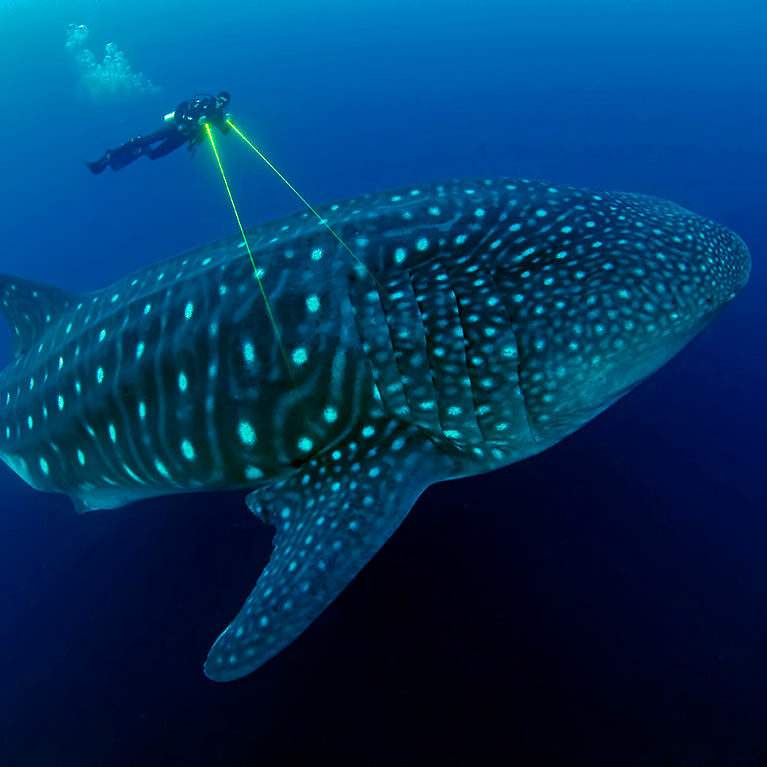Secrets of the whale sharks of the Galápagos Marine Reserve
Jonathan is tracking whale shark movement patterns using different satellite tags to understand where they are moving in and around the Galápagos Marine Reserve. To what depths are they diving? How do they use different habitats? This information is vital to identify key areas for their survival.
For as long as I can remember, I’ve been fascinated by icy regions, polar exploration and the ocean. One of my earliest childhood recollections is being stuck inside on a rainy day in northern England and coming across a leather-bound edition of Jacques Cousteau’s The Silent World. From that moment my future was clear to me: I would learn to dive and I’d explore the underwater world. Not so clear was how I would achieve this, but then things fell into place as if meant to be. After school I went to the local college of further education to improve...
Secrets of the whale sharks of the Galápagos Marine Reserve
Discover crucial data about the natural history of the whale shark, Rhyncodon typus, particularly the reproductive state of the individuals that passes through the Galapagos Marine Reserve each season.
The Galapagos Marine Reserve is the only location in our oceans, to date, where a population of nearly 100% females has been identified and thus unique in terms of study group. The lack of data about key aspects of whale sharks means that their conservation status if almost certainly in decline and urgent action must be taken to protect this species for the future. Whale sharks are currently being targeted by industrial fishing fleets, primarily for the Asian market demand of shark fin and squalene oil. There are few controls and virtually no sanctions for this type and level of fishing which is most certainly not sustainable.
No action toward their protection can be made without baseline data that identifies certain aspects or elements of their natural history, such as migratory routes, breeding and birthing grounds and where the young are living for the first years of life. Once their key factors have been identified we can begin to work towards finding ways of mitigating the effects of such fishing and protecting key areas in order to allow whale sharks to complete their life cycle. Whilst protection of whale sharks is the primary objective of this project, the protection of such iconic species, the awareness created by the study and the educational benefits of the study create a massive “umbrella” effect which helps protect an infinite number of species that live in the same habitat having a huge knock on effect in terms of marine conservation.
When I began diving in the Galapagos in 1988 I heard about occasional whale shark sightings. I saw my first individual in 1990 when carried off the dive site at Darwin Arch close by Darwin Island at the very north of the archipelago. I began asking questions of scientists and colleagues and was amazed at how little was known about the natural history, even where they were breeding, birthing and feeding. I put together a project and began collecting photos and a short data sheet about sightings which I distributed amongst a few of the dive masters that regularly went to the north at that time, (as the dive business was only just beginning to grow in the Galapagos). I quickly realised two things, one that the population was much bigger than previously supposed and two that most were apparently female. I also realised at that time that a simple questionnaire and photo ID would not give us the data that we needed in order to begin to understand their movements in and around the Galapagos Marine Reserve (not yet denominated), and on a regional, less still a global scale.
In order to protect the species we urgently need to better understand the natural history of the species and identify possible hotspots. Where they are feeding, mating and birthing and equally urgent where the neonates live for their first years of life. Regional bycatch from industrial and artisanal fisheries are not showing evidence of high level of encounters (a very positive thing), which also might indicate that birthing is NOT pelagic as previously assumed. Could it be that they are birthing in offshore environments but on seamounts and underwater platforms such as the Galapagos? After a period of 6 years fundraising and creating awareness about the necessity to study this species the Galapagos Whale Shark Project began with an ambitious satellite tagging program which continues today. Despite the fact that we have a much clearer idea of how whale sharks move around the marine reserve and at a regional scale we still do not know where they are birthing and how Galapagos might play a role in this.
In 2014 we teamed up with the BBC Blue Planet II team and the project’s work was featured in Episode 7, “Our Blue Planet” helping raise awareness of the species and the oceans as a whole. In 2018 we carried out the first ever successful blood draw and ultrasound examinations of free swimming whale sharks. Despite identifying the ovaries and egg follicles and analysing hormonal levels we still do not have conclusive evidence of reproductive state. Data from the research carried out by the GWSP has been used for policy writing and for the direct implementation of legislation by two nations, Ecuador and Costa Rica for the establishment of a Marine Corridor between Galapagos and Cocos Islands to protect pelagic and oceanic migratory species such as the whale shark and other sharks. The work continues as we seek to discover more data using the ever evolving technology to attempt to identify those area most in need of protection for this iconic species and all the “umbrella” species that would benefit from Marine Protected Areas.
- Determine reproductive state and whether the Galapagos Marine Reserve or nearby areas may be birthing sites or areas where young pups spend their formative years before venturing into a pelagic environment
- Determine movements on a local and regional scale
- Determine vertical movements and dive profiles with reference to benthic geology and geomorphology to see how these might be influenced by seafloor features and to see if this provides indicators as to feeding, breeding and birthing habitat and habitat use
- Photo identification to determine frequency and site fidelity within the Galapagos Marine Reserve as well as on a regional and global level. Also to determine travel / migration routes on a regional and global level
- Use DNA and blood to determine oceanic connectivity and the presence of anthropogenic pollutants such as micro plastics.


